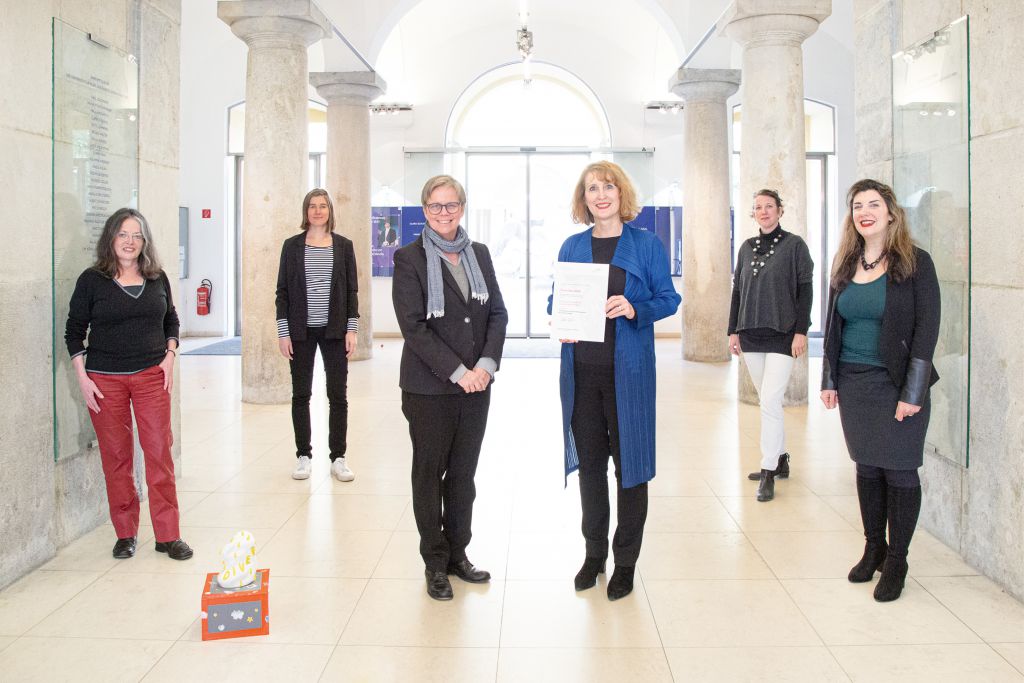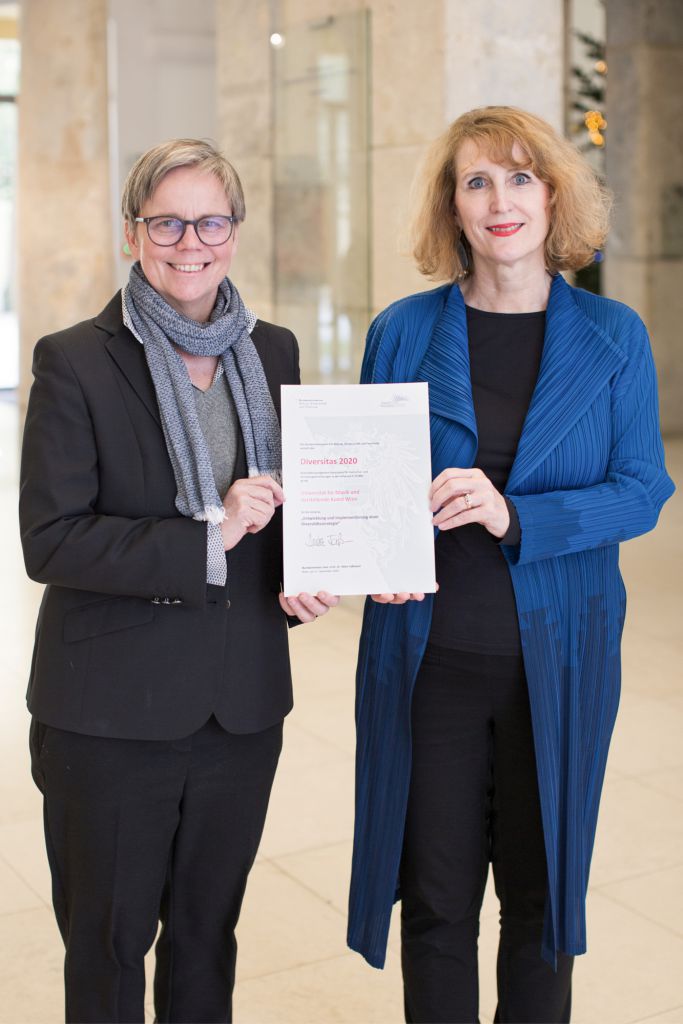It is immensely gratifying that Austria’s Federal Ministry of Education, Science and Research has once again awarded a Diversitas Prize to the mdw! It was in 2016 that the mdw received its first Diversitas Prize for “All Stars Inclusive”, an inclusive band that has continued its activities at the mdw ever since.
For what exactly did the mdw receive this award?
For the ambitious project of developing and implementing a diversity strategy in a university-wide process with the aim of helping to bring about a more discrimination-free studying and working environment.

Who initiated this strategy?
It was Vice Rector for Organisational Development, Gender & Diversity Gerda Müller who originally took the initiative to launch a broad strategic development process on the theme of diversity at the mdw. This participative process, which ran for two years (2017–2019), involved 80 contributors situated at various hierarchical levels and from all three of the University’s core groups—students, faculty members, and administrators. The process was implemented by the Administrative Department for Equality, Gender Studies & Diversity (GGD) and subsequently intensified from 2018 onward via the addition of a diversity manager (Ulrike Mayer). 2019 then saw a diversity strategy appropriate to the needs of the mdw enacted by the Rectorate and made public in the University Bulletin. Since then, work has proceeded on the implementation of this strategy’s collaboratively developed measures. (See Illustration, mdw diversity scorecard.)
Why such a long and elaborate process for the development of a diversity strategy?
Because when the idea is to have a large number of people from different core groups engage in a process aimed at shaping our university in a democratic way, things just take time. It’s also necessary to discuss and deal with some things at length as well as include a diversity of perspectives in order to draw well-considered conclusions and take effective actions. And an additional reason is that in our 21st-century society and particularly in the field of education, perceiving and lending visibility to diversity, dimensions of inequality, and the heterogeneity of identities and social positionings consistently also entails “simultaneously shifting questions of power and societal exclusion into the realm of awareness” (Eggers 2001, p. 256). After all, not everyone has the same access to resources, knowledge, positions, or institutions. What’s more, it’s a well-known fact that, in Austria, education has been and continues to be something of an “inherited” asset.
There never will be a cookie cutter formula for a diversity strategy’s reliable success. But it’s unequivocally the case that the greater the number of people who participate in such a process at an expert-institution such as a university, the more people (in this case: university community members) can be taken along on a deliberate journey towards a future of education with greater equality of opportunity and towards a university with esteeming configurations and structures of communication. And: the more knowledge fit to support a critical approach to discriminatory practices that can be brought into circulation and practically applied, the more sustainable such a process will be.
What does learning to perceive diversity and recognising its value mean?
We’ve inhaled lots of things as black or white, good or bad; strong value judgements permeate our everyday lives and are thus (for the most part unconsciously) inscribed onto our perceptions, language, imagery, and actions. “Prejudices and discriminatory knowledge have entered our heads via socialisation, children’s books, movies, and stories told by people close to us, and they affect us when we sit on commuter trains, encounter people in supermarkets, or conduct hiring interviews” (Schütze/Maedler 2017, p. 41). Turning a critical eye on oneself rather than a “self-righteous gaze upon the Other” (Wiesböck 2018), on the conditions of one’s own socialisation and the privileges and affiliations linked therewith as well as one’s own conscious and unconscious prejudices is an important first step where diversification processes are concerned. For such processes’ “programmatic aim consists in ensuring equal rights and realising equal access in order to dismantle inequalities and social hierarchies” (Eggers 2001, p. 257). So if we intend to deal critically with diversity, we must speak not only of diversity as variety or differentiation but also about privileges, power structures, and discrimination. Power structures (racism, sexism, classism, ableism, etc.) “as learned by and taught to us from an early age since they are inscribed in cannons, educational offerings, and institutions and thus constantly reproduced” (Schütze/Maedler 2017, p. 9) must be identified, reflected upon, and unlearned. In this regard, and especially before the backdrop of an educational climate that is increasingly characterised by neoliberal economisation and the concept of the entrepreneurial university, Eggers speaks of a phenomenon of de-politicisation and a politics of “harmonising” diversity—for “consumable diversity (the condition) represents a further disarming of the socially critical potential inherent in diversification (the process) as an instrument of change. A superficial understanding of diversity as a possible way of defusing or even eliminating the tensions arising from societal inequalities contributes to successive de-politicisation” (Eggers 2001, p. 258).
What measures entailed by the mdw Diversity Strategy are to be implemented?

The mdw diversity scorecard embodies the Diversity Strategy’s roadmap, providing an overview of the planned measures and serving as an important tool with which to follow up and evaluate whether these measures are proving successful in terms of the goals that have been set and/or whether and where adaptations are needed.
A diversity strategy that aims to contribute to a discrimination-free studying and working environment will never be entirely finished; even so, one can indeed say that much has happened and changed since 2017. It can likewise be said that much work still lies ahead of us—and that not every measure will instantly contribute to visible and palpable change. What’s certain, in any case, is that the mdw Diversity Strategy represents a contribution toward making the mdw fairer and more democratic.
Cited literature
Eggers, Maisha Auma (2001). “Diversity/Diversität” in: Arndt, Susan; Ofuatey-Alazard, Nadja (eds.). Wie Rassismus aus Wörtern spricht. (K)erben des Kolonialismus im Wissensarchiv deutsche Sprache. Münster, Unrast.
Mayer, Ulrike (2020). “Der Ansatz ‚Kritischer Diversität‘ am Beispiel der Diversitätsstrategie der Universität für Musik und darstellende Kunst Wien”, ZDfm – Zeitschrift für Diversitätsforschung und -management, 1–2020, pp. 76-82. Open access: budrich-journals.de/index.php/zdfm/article/view/35175/30100
mdw-magazin Special on “Diversity”: mdw.ac.at/magazin/index.php/2019/09/30/special-diversitaet
Schütze, Anja; Maedler, Jens (eds.) (2017). weiße Flecken. Diskurse und Gedanken über Diskriminierung, Diversität und Inklusion in der Kulturellen Bildung. München, kopaed.
Wiesböck, Laura (2018). In besserer Gesellschaft. Der selbstgerechte Blick auf die Anderen. Vienna, Kremayr & Scheriau.

